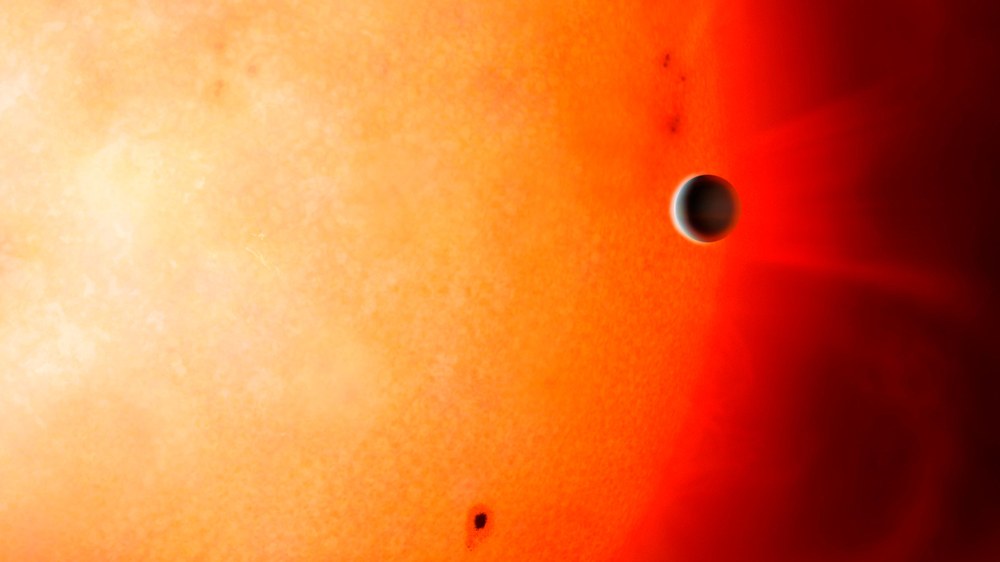NGTS discovers a ‘forbidden planet in the Neptunian desert’

- The DLR-funded Next-Generation Transit Survey (NGTS) telescope array has found a planet in the ‘Neptunian desert’ – the region close to a star where scientists had long believed that there were no planets of this size.
- The signals used to detect the planet NGTS-4b are the weakest ever detected by a ground-based search programme.
- Focus: Exploration, exoplanets, planetary research
Planets located near stars must endure a lot – from powerful solar winds to intense X-rays and strong ultraviolet radiation. The area where a planet is so close to its host star that it can complete its orbit in less than four Earth days and in which there are no Neptune-sized planets is referred to as the ‘Neptunian desert’. This is a reference to the fact that, until now, no medium-sized planets similar to Neptune have been found at this distance – only large planets comparable with Jupiter and smaller planets like Mars. This has now changed; in 2018, a group of researchers in Chile, co-funded by the German Aerospace Center (Deutsches Zentrum für Luft- und Raumfahrt; DLR) used one of the telescopes in the Next-Generation Transit Survey (NGTS) array to discover a planet in one such Neptunian desert. The planet has been named NGTS-4b as it is orbiting the dwarf star NGTS-4, which is located approximately 900 light years from the Solar System.
Planet NGTS-4b has an orbital period of just 32 hours – equivalent to just over one-and-a-quarter Earth days. This is many times shorter than even Mercury – the planet with the shortest year within the Solar System – which has a year that lasts 88 Earth days. With an estimated diameter of almost 40,000 kilometres, NGTS-4b is about 20 percent smaller than Neptune and has three times the radius of Earth. Many of the nearly 4000 previously discovered extrasolar planets have similar dimensions. However, multi-planetary systems – in which planets orbit a star at Earth-like or greater distances and at a comparatively ‘leisurely’ speed – are still the exception in the exoplanet catalogues.
How does NGTS-4b resist atmosphere stripping?
The atmospheric properties of NGTS-4b have made its discovery extremely significant within the scientific community. “It is thought that NGTS-4b has only survived because it has a particularly large core, or because it migrated close to its host star only at a later stage, once the star’s radiation had already reduced,” says Philipp Eigmüller, one of the six scientists from the DLR Institute of Planetary Research in Berlin who were involved in the discovery. Normally, a planet with the mass of Neptune and a similar composition would very quickly lose its shell of hydrogen and helium due to the strong radiation from its host star, leaving only the exposed core. A similar scenario is also under discussion for the early evolution of the planet Mercury. Larger bodies exert a stronger attraction on their outer shell because of their greater mass and thus prevent the loss of their atmosphere.
The NGTS telescope array has detected the weakest transit signal to date
The NGTS telescope array has 12 automatic telescopes that use the transit method to search for planets in other star systems. Each telescope observes a section of sky that is approximately three degrees across. The telescopes record the very small dip in brightness that occurs when a planet passes in front of its host star. The transit signals of the planet that has now been discovered are the weakest with which a planet has ever been discovered from the ground. The star NGTS-4 is not visible from Earth with the naked eye. Its apparent brightness is about the same as that of Pluto, on the outer edge of the Solar System – over six million times lower than the apparent brightness of Jupiter. During its transits, NGTS-4b decreases the brightness of its hosts star by only approximately 0.13 percent. No other ground-based search programme is capable of detecting such weak signals.
Data from the NGTS telescope array are freely available
Since the telescope array began searching for extrasolar planets in 2016, 1.7 terabytes of data have been made available. This includes measurements of 200,000 stars and their light curves. The discovery of four planets has been confirmed since NGTS was commissioned. Approximately 4000 extrasolar planets are known today. “Each one is like a piece of the puzzle with which we can understand more and more about the formation and evolution of planets,” says Eigmüller. The data from the first year of observations by NGTS with all 12 telescopes (April 2016 – April 2017) are freely accessible online in the ESO Archive and are open to evaluation by scientists all over the world.
About NGTS
The Next-Generation Transit Survey (NGTS) telescope array was built by a consortium of British, Swiss and German institutions and is located at the European Southern Observatory (ESO) Paranal Observatory in the Atacama Desert in northern Chile. There, it benefits from excellent observing conditions and technical support from the other facilities. It is designed for large-scale sky surveys and was funded largely by DLR, which provided eight of the 12 cameras. Scientists from the DLR Institute of Planetary Research evaluate the data as part of an international team. NGTS is designed in such a way that it continuously and fully automatically measures the brightness of several hundred thousand comparatively bright stars in the southern sky as it searches for exoplanet transits.


